It looks like you're using an Ad Blocker.
Please white-list or disable AboveTopSecret.com in your ad-blocking tool.
Thank you.
Some features of ATS will be disabled while you continue to use an ad-blocker.
8
share:
www.msnbc.msn.com...
I'm sorry I don't know how to post this link. But The Seals have hairloss and bleeding skin wounds and they are dying in Alaska. It seems to me this could be from Fukushima and it angers me that there is no mention of testing them for that! Scientists are not sure what caused it but are guessing its a virus. This seems to be blantant avoidance! I'm so angry and sad about this. We need to spread the word and get these seals checked. The truth has to come out. But how? Any ideas??
I'm sorry I don't know how to post this link. But The Seals have hairloss and bleeding skin wounds and they are dying in Alaska. It seems to me this could be from Fukushima and it angers me that there is no mention of testing them for that! Scientists are not sure what caused it but are guessing its a virus. This seems to be blantant avoidance! I'm so angry and sad about this. We need to spread the word and get these seals checked. The truth has to come out. But how? Any ideas??
well the symptoms would suggest radiation poisioning
not good
not good
Originally posted by rubyeyes
www.msnbc.msn.com...
I'm sorry I don't know how to post this link. But The Seals have hair loss and bleeding skin wounds and they are dying in Alaska.
It seems to me this could be from Fukushima and it angers me that there is no mention of testing them for that!
Scientists are not sure what caused it but are guessing its a virus.
This seems to be blantant avoidance!
I'm so angry and sad about this.
We need to spread the word and get these seals checked.
The truth has to come out.
But how? Any ideas??
Greetings:
Seems like the link is OK to us.
Good catch (pun intended).
We have been attempting to sound the alarm for about seven months now about the incessant bombardment of life-altering radiation poisoning of virtually all of North America.
Perhaps this is one of the first signs that something is truly amiss in the seas off America.
Perhaps contacting the EPA by a few thousand interested parties with questions like:
"Were these seals tested for radioactivity?"
might be in order.
We'll bring this up on the mega-thread and push from that side.
Thank you for your time and concern.
In Peace, Love & Light
tfw
It does appear to state in the article that samples are being sent around for testing so perhaps the cause will become known. I imagine if it has to
do with radiation poisoning then this will become known, although clearly there is always the possibility of cover ups.........
reply to post by Flavian
The actual cause will never be told. I would love for them to come out and say it but to admit that means admitting all the wild fish caught for human consumption in those areas, and the crabs, may also be affected.
They will not say a peep. That I guarantee you.
The actual cause will never be told. I would love for them to come out and say it but to admit that means admitting all the wild fish caught for human consumption in those areas, and the crabs, may also be affected.
They will not say a peep. That I guarantee you.
edit on 14-10-2011 by LightAssassin because: (no reason given)
reply to post by rubyeyes
It's very possible, but any number of toxins could produce similar, or somewhat similar symptoms. Radiation poisoning at that level should show-up as destruction of intestinal flora. The inability to digest food at the cellular level, (actually not able to process it threw the lining of the intestines) also would produce massive diarrhea and subsequent dehydration, but you can get that from things like e-coli infections. In severe cases you see sloshing off and expulsion of G.I tract cells, that can be determined pretty easily as being caused by radiation, and not a toxin (again most) or infection.
Whatever the cause it seems man made, but I can't be sure. Never the less it would seem the animals are in agony, and that makes me very angry, what ever the cause. It's a lot worse if it's the result of human mistakes, or stupidity. As to how this can be determined you need to catch several of the animals for testing. Greenpeace, NOAA, and most larger Navies, not to mention numerous scientific/academic institutions have the capacity to do this. In the interest of public, and wildlife health we should. Considering the total dose released from the reactors, that we know about it's very sadly, quite possible. Acute severe radiation poisoning is ghastly. The people of Japan know that better as a people then anyone, or any living thing, should.
It's very possible, but any number of toxins could produce similar, or somewhat similar symptoms. Radiation poisoning at that level should show-up as destruction of intestinal flora. The inability to digest food at the cellular level, (actually not able to process it threw the lining of the intestines) also would produce massive diarrhea and subsequent dehydration, but you can get that from things like e-coli infections. In severe cases you see sloshing off and expulsion of G.I tract cells, that can be determined pretty easily as being caused by radiation, and not a toxin (again most) or infection.
Whatever the cause it seems man made, but I can't be sure. Never the less it would seem the animals are in agony, and that makes me very angry, what ever the cause. It's a lot worse if it's the result of human mistakes, or stupidity. As to how this can be determined you need to catch several of the animals for testing. Greenpeace, NOAA, and most larger Navies, not to mention numerous scientific/academic institutions have the capacity to do this. In the interest of public, and wildlife health we should. Considering the total dose released from the reactors, that we know about it's very sadly, quite possible. Acute severe radiation poisoning is ghastly. The people of Japan know that better as a people then anyone, or any living thing, should.
edit on 14/10/11 by arbiture because: Add on
This need to be investigated because the Seals are an important Indicator/ Factor
in the arctic Food Chain!
But this can be everything, from Radiation until AIDS or a Parasite!
I really hope that the Americans are quick
Funny thing is that since a few days we have a Seal here in the River,
she looks very healthy and happy!
in the arctic Food Chain!
But this can be everything, from Radiation until AIDS or a Parasite!
I really hope that the Americans are quick
Funny thing is that since a few days we have a Seal here in the River,
she looks very healthy and happy!
edit on 14-10-2011 by Human0815 because: (no reason given)
Originally posted by ShortMemory
well the symptoms would suggest radiation poisioning
not good
Greetings:
We posted this on Japan Declares a Nuclear Emergency.
Could this be another chink in the armor, another hole in the dike - if you will - after all, this is MSNBC...?
Mysterious disease kills scores of seals in Alaska - msnbc.com
ANCHORAGE, Alaska — A mysterious disease, possibly a virus, has afflicted ringed seals along Alaska's coast, killing scores of them since July, local and federal agencies said on Thursday.
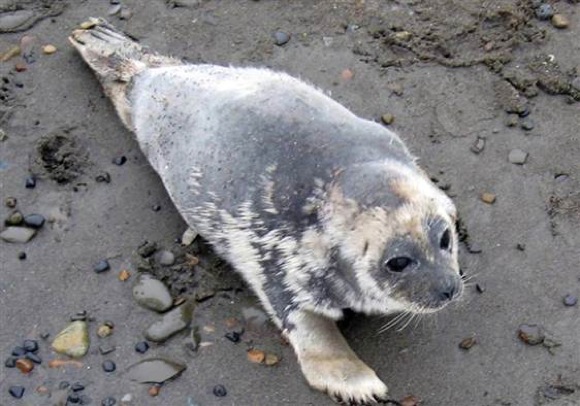
A photo provided by the North Slope Borough shows a ringed seal with significant hair loss on the Arctic Ocean coast near Barrow, Alaska, in September.
The diseased seals have been beaching themselves on the Arctic coastline since July, [color=limegreen]with numbers picking up in subsequent months, biologists with the North Slope Borough Department of Wildlife Management and other agencies said.
About 100 of the diseased animals have been found near Barrow, the nation's northernmost community, and half of those have died, the borough biologists reported.
(...)
And the naysayers say the mounting evidence is "anecdotal..."
Ringed seals rarely come ashore in normal circumstances, spending most of the year in the water or on floating ice, according to the National Oceanic and Atmospheric Administration's Fisheries Service.
Biologists said they believe the illness was caused by a virus.
Symptoms include sometimes-bleeding lesions on the hind flippers, irritated skin around the nose and eyes and patchy hair loss on the animals' fur coats.
Why does this sound familiar?
They said the mystery outbreak may not be limited to ringed seals.
Hummmmmm - a trans-species virus?
Some dead walruses at Point Hope, a village on Alaska's northwest coast, were found with similar lesions, borough biologists said.
Local hunters also reported finding skin lesions on two bearded seals, the biologists said.
Yet identification of the disease remains elusive, and it was not clear that the lesions found on the walruses were from the same disease that has afflicted the ringed seals, said Bruce Woods, spokesman for the U.S. Fish and Wildlife Service.
more
Huh?
"We're kind of in the dark at this point," he said.
And these are the "experts" who are supposedly in charge of keeping we, the people, safe?
The remote locations and other logistical challenges make it impossible to provide veterinary care to beached animals that are sick, said Jason Herreman, a borough biologist.
"Seals that are found dead are collected for sampling. Seals that are sick but alive are being left to recover on their own," he said in an e-mail. Samples were being sent to various laboratories in Anchorage and elsewhere, he said.
Wouldn't want any radioactive dying seals for the press to photograph, would we?
Ringed seals, bearded seals and Pacific walruses are all dependent on floating summer sea ice and are suffering the impacts of rapid warming in the Arctic, according to federal agencies.
NOAA has proposed listing Alaska's ringed seals and bearded seals as threatened, and the Fish and Wildlife Service has also designated the Pacific walrus as a candidate for Endangered Species Act protections.
Oh, there won't be any follow-up - no hard questions?
Let's take a closer look at what we speak of:
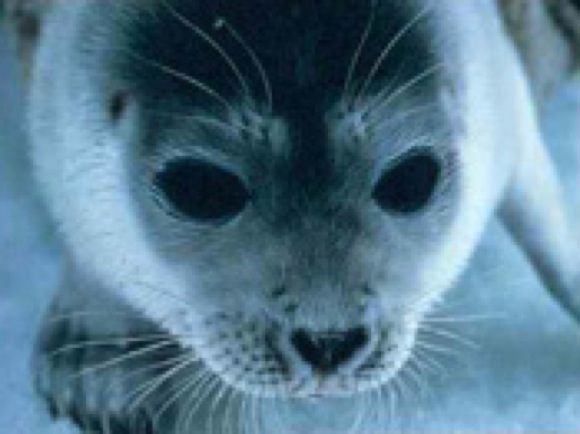
Ringed Seal (Phoca hispida) - Office of Protected Resources - NOAA Fisheries
Ringed seals are part of the "true seal" family Phocidae. The ringed seal is the smallest and most common seal in the Arctic. They have a small head, short cat-like snout, and a plump body. Their coat is dark with silver rings on their back and sides with a silver belly. Their small foreflippers have claws more than 1 inch (2.5 cm) thick that are used to maintain breathing holes through 6.5 ft (2 m) thick ice.
They grow to average lengths of 5 ft (1.5 m) with weights ranging from 110-150 lbs (50-70 kg). Ringed seals live about 25 to 30 years.
They are solitary animals and when hauled out on ice separate themselves from each other by hundreds of yards.
Did You Know?
· Females construct lairs within the thick ice and give birth in these structures.
· Ringed seals are a preferred prey of polar bears.
· The ringed seal is the smallest and the most common seal in the Arctic.
The smallest, weakest, and or youngest is generally the "canary in the mine."
We have been warned.
To be continued...
In Peace, Love & Light
tfw
Originally posted by thorfourwinds
The smallest, weakest, and or youngest is generally the "canary in the mine."
"Canary in the mine." Very insightful, thofourwinds. And very frightful.
Thank you for your post.
Were their gums bleeding? These symptoms listed are the most common symptoms for any sick animal, so its impossible to diagnose with just those
symptoms.
It is possible there is stuff in the air and water, SICKENING
(Continued from previous page)
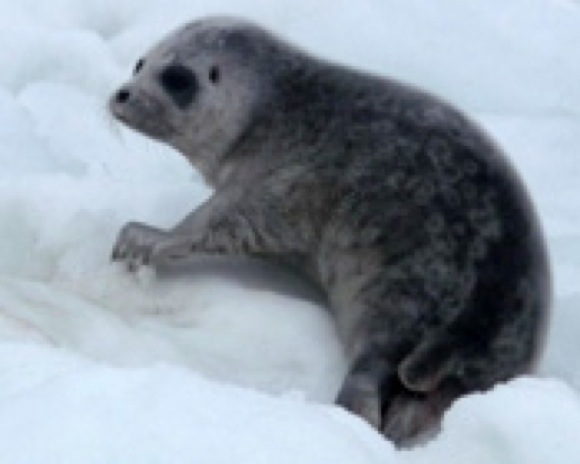 Photo: Shawn Dahle, NOAA Polar Ecosystems Program Research Cruise
Photo: Shawn Dahle, NOAA Polar Ecosystems Program Research Cruise
Ringed Seal Pup (Phoca hispida)
Ringed Seal Range Map
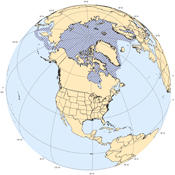 (click for larger view PDF)
(click for larger view PDF)
Ahem.
If, in fact, "this species is protected under the Marine Mammal Protection Act of 1972 as amended," then, we, the people, are being denied due process due to the fact that NOAA Fishieries/Office of Protected Resources is not doing their job in regards to Marine Mammal Stock Assessment Reports (SARs).
To be more precise:
Oops!
Kind of like the EPA saying they don't have to monitor for radiation because they say it is not there to be monitored...
And,
OK, so how's that working out for you?
How's this for spin?
Japan Disaster Radiation Effect On Wildlife And Ocean Life
After how many years of intensive study...?
WTF?
"As we might expect?"
Based on what?
Is that like being half-pregnant?
What type of "short term harm the radiation" are these morons speaking about?
This?
Radiation Can Cause 'Bizarre Mutations'
To be continued...
In Peace, Love & Light
tfw

Ringed Seal Pup (Phoca hispida)
Habitat
Ringed seals reside in arctic waters and are commonly associated with ice floes and pack ice.
Ringed Seal Range Map

Distribution
The ringed seal is found in the Northern Hemisphere with a circumpolar distribution ranging from 35°N to the North Pole.
[color=limegreen]There is only one recognized stock of ringed seals in U.S. waters: the Alaska stock.
Population Trends
The estimated population size for the Alaska stock of ringed seals is 249,000 animals.
Currently, the population trend for this stock is unknown.
Threats
Ringed seals are harvested annually by Arctic natives for subsistence.
By catch in fishing gear, such as commercial trawls, is also another threat to ringed seals
Climate change is potentially the most serious threat to ringed seal populations since much of their habitat is dependent upon pack ice.
Conservation Efforts Ringed seals are considered Low Risk-least concern in the IUCN Red List of species.
Regulatory Overview This species is protected under the Marine Mammal Protection Act of 1972 as amended.
Ahem.
If, in fact, "this species is protected under the Marine Mammal Protection Act of 1972 as amended," then, we, the people, are being denied due process due to the fact that NOAA Fishieries/Office of Protected Resources is not doing their job in regards to Marine Mammal Stock Assessment Reports (SARs).
To be more precise:
What information can I find in a stock assessment report? Each report includes:
▪ a description of the stock's geographic range
▪ a "minimum population estimate"
▪ [color=limegreen]current population trends
▪ current and maximum net productivity rates
▪ "Potential Biological Removal" levels
▪ status of the stock
▪ estimates of annual human-caused mortality and serious injury by source
▪ descriptions of other factors that may be causing a decline or impeding the recovery of "strategic stocks"
Population Trends
The estimated population size for the Alaska stock of ringed seals is 249,000 animals.
Currently, the population trend for this stock is unknown.
Oops!
Kind of like the EPA saying they don't have to monitor for radiation because they say it is not there to be monitored...
And,
How is the information used?
This information is used to:
▪ identify and evaluate the status of marine mammal populations and the effects of human activities upon them
▪ authorize the "taking" of marine mammals incidental to human activities
▪ design and conduct appropriate conservation measures
▪ [color=limegreen]evaluate the progress of each fishery in reducing its incidental mortality and serious injury to insignificant levels approaching a zero mortality and serious injury rate
OK, so how's that working out for you?
How's this for spin?
Japan Disaster Radiation Effect On Wildlife And Ocean Life
While the full effects of the radiation pollution on wildlife are difficult to predict,...
After how many years of intensive study...?
... looking back at similar events in Chernobyl and Bikini Atoll, we find that the outlook for wildlife is not as grim as we might expect, according to information gathered by Sciencemag.org.
Examining the effects on animals near Chernobyl and Bikini Atoll [color=limegreen]animals can suffer short term harm from the radiation, but will, in the long term, recover.
WTF?
"As we might expect?"
Based on what?
Is that like being half-pregnant?
What type of "short term harm the radiation" are these morons speaking about?
This?
Radiation Can Cause 'Bizarre Mutations'
Once in seawater, radiation can hurt ocean animals in several ways—by killing them outright, creating “bizarre mutations” in their offspring, or passing radioactive material up the food chain, according to Joseph Rachlin, director of Lehman College’s Laboratory for Marine and Estuarine Research in New York City.
“There will be a potential for a certain amount of lethality of living organisms, but that’s less of a concern than the possible effects on the genetics of the animals that become exposed,” Rachlin said.
“That’s the main problem as I see it with radiation—altering the genetics of the animal and interfering with reproduction.”
To be continued...
In Peace, Love & Light
tfw
edit on 14/10/2011 by thorfourwinds because: format
If animals were swimming right off the coast of Japan and turned up with symptoms like these I might suspect radiation poisoning.
Originally posted by rubyeyes
The Seals have hairloss and bleeding skin wounds and they are dying in Alaska. It seems to me this could be from Fukushima
That's because they could be close enough to a concentrated source of radiation release to show these symptoms.
However, in Alaska, there is so much water between Japan and Alaska, that the radiation would be diluted significantly before it gets to Alaska, so it's difficult to imagine this could be the result of Fukushima at that vast distance and with all the water in the Pacific ocean to dilute the radiation.
They are doing tests to figure out what's causing it but if the biologists think it's probably a virus, I don't think there's enough information to contradict them, but by all means they need to continue the analysis to determine the actual cause more definitively.
I think it's a strong possibility, if not a certain one.
We've had confirmation, of a sorts through the Japanese media and the activists there in Japan, that the radiation going into the sea has not slacked off.
We really need tracking collars and other such information on the migratory animals and sea life that trek through that region.
M.
We've had confirmation, of a sorts through the Japanese media and the activists there in Japan, that the radiation going into the sea has not slacked off.
We really need tracking collars and other such information on the migratory animals and sea life that trek through that region.
M.
reply to post by Moshpet
(Continued from previous page)
And this:
Radioactive caesium found in whales
And this:
Marine Life At Higher Risk From Radiation In Japan Than Expected
What type of "in the long term, recover." are these morons speaking about?
This?
Acceptable risk vs. collateral damage?
And, from the wayback machine:
5 April 2011
ALERT: Fish Near Fukushima at 4000% Above Codex Alimentarius Limit for Radioactive I-131 — Yet US Says Eating It Poses NO Health Risk
This is just too good.... you can't make this up folks, as no one would believe you.
May we bring your attention to the word, "stricken?"
Even though this is only 25 days into the event, the fix is clearly in.
The FDA, EPA & CDCP "express confidence" that they would detect a [color=limegreen]single contaminated fish.
Too bad illegals coming through Mexico across our Southern Border aren't 'sufficiently contaminated' so those other agencies could have a shot (pun) at stopping the real bad guys... Border Patrol seems to unable, hampered, inadequate, or ...?
hmmmmmm... wait just a minute...
But, does one think that these talking heads would actually eat any of this fish?
Just a reminder...
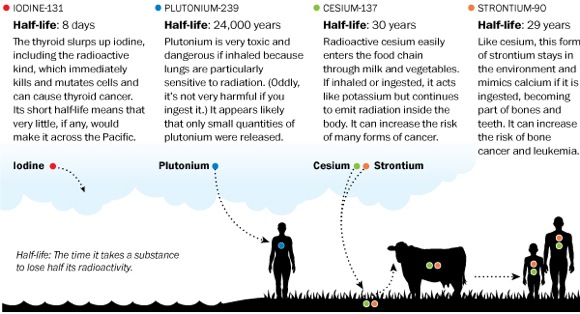

Government Radiation Expert Deconstructs Myth Of “Safe” Radiation Levels
Joseph Conrad wrote:
[color=limegreen]After all the shouting is over, the grim silence of facts remain.
in Peace, Love & Light
tfw
(Continued from previous page)
And this:
Radioactive caesium found in whales
And this:
Marine Life At Higher Risk From Radiation In Japan Than Expected
While the ocean has a high capacity for diluting radiation, the radioactive isotope levels in the sea near Japan’s eastern coast bring higher risk of death, mutation, and genetic degradation for marine life than previously predicted.
What type of "in the long term, recover." are these morons speaking about?
This?
[color=limegreen]The greatest threat is to the future generations of sea creatures; the radiation could interfere with reproduction and the development of young, causing a collapse of the population. — Global Animal
Acceptable risk vs. collateral damage?
And, from the wayback machine:
5 April 2011
ALERT: Fish Near Fukushima at 4000% Above Codex Alimentarius Limit for Radioactive I-131 — Yet US Says Eating It Poses NO Health Risk
This is just too good.... you can't make this up folks, as no one would believe you.
U.S. public-health officials sought Tuesday to reassure consumers about the safety of food in the U.S., including seafood, amid news that fish contaminated with unusually high levels of radioactive materials had been caught in waters 50 miles from the stricken Fukushima nuclear plant in Japan.
May we bring your attention to the word, "stricken?"
Even though this is only 25 days into the event, the fix is clearly in.
No contaminated fish have turned up in the U.S., or in U.S. waters, according to experts from the Food and Drug Administration, Environmental Protection Agency and Centers for Disease Control and Prevention.
They expressed confidence that even a single fish sufficiently contaminated to pose a risk to human health would be detected by the U.S. monitoring system.
The FDA, EPA & CDCP "express confidence" that they would detect a [color=limegreen]single contaminated fish.
Too bad illegals coming through Mexico across our Southern Border aren't 'sufficiently contaminated' so those other agencies could have a shot (pun) at stopping the real bad guys... Border Patrol seems to unable, hampered, inadequate, or ...?
hmmmmmm... wait just a minute...
They also dismissed concerns that eating fish contaminated at the levels seen so far in Japan would pose such a risk.
But, does one think that these talking heads would actually eat any of this fish?
Thomas Frieden, head of the CDC in Atlanta, said he expected continued detection of low levels of radioactive elements in the water, air and food in the U.S. in coming days, but that readings at those levels do not indicate any level of public health concern.
source
Just a reminder...


Government Radiation Expert Deconstructs Myth Of “Safe” Radiation Levels
Since the Fukushima accident we have seen a stream of experts on radiation telling us not to worry, that the doses are too low, that the accident is nothing like Chernobyl and so forth. They appear on television and we read their articles in the newspapers and online. Fortunately the majority of the public don’t believe them.
(...) more
(...)
There is a gap between them and us.
Between the phoney scientists and the public who don’t believe what they say.
Between those who are employed and paid to protect us from radioactive pollution and those who die from its consequences.
Between those who talk down what is arguably the greatest public health scandal in human history, [color=limegreen]and the facts that they ignore.
Joseph Conrad wrote:
[color=limegreen]After all the shouting is over, the grim silence of facts remain.
in Peace, Love & Light
tfw
edit on 14/10/2011 by thorfourwinds because: colortag
It could be radiation poisoning, or it could be a virus that's been frozen under the ice for thousands of years, and is just now starting to
resurface and cause havoc because of climate change.
Not sure.
Not sure.
reply to post by Human0815
Keeping a close eye on whats going on in all areas of nature, as much as possible can be very helpful in spotting problems in the environment long before people start growing a third eye. Amphibians and birds are super-sensitive to toxins. Birds in particular are very easily affected by low levels of ionizing radiation and non-ionizing radio frequency "back ground noise" As well as EMF from power lines, microwave relay towers, radar emitters, etc. When they start having problems, or just act "weird" it's a really good idea finding out why...
Keeping a close eye on whats going on in all areas of nature, as much as possible can be very helpful in spotting problems in the environment long before people start growing a third eye. Amphibians and birds are super-sensitive to toxins. Birds in particular are very easily affected by low levels of ionizing radiation and non-ionizing radio frequency "back ground noise" As well as EMF from power lines, microwave relay towers, radar emitters, etc. When they start having problems, or just act "weird" it's a really good idea finding out why...
It's happening in Canada and Russia too.
FAIRBANKS, Alaska, Dec. 12 (UPI) -- Veterinarians in Alaska say they don't know what has killed almost 200 arctic ringed seals since July, with similar deaths reported in Canada and Russia
www.upi.com...
reply to post by Arbitrageur
Its not just the jetstream overhead. The major freeway of currents goes straight off japan to North America and up to Alaska.
We're really getting it direct.
Kuroshio Current
en.wikipedia.org...
Its not just the jetstream overhead. The major freeway of currents goes straight off japan to North America and up to Alaska.
We're really getting it direct.
Kuroshio Current
en.wikipedia.org...
new topics
-
Weinstein's conviction overturned
Mainstream News: 31 minutes ago -
Supreme Court Oral Arguments 4.25.2024 - Are PRESIDENTS IMMUNE From Later Being Prosecuted.
Above Politics: 2 hours ago -
Krystalnacht on today's most elite Universities?
Social Issues and Civil Unrest: 2 hours ago -
Chris Christie Wishes Death Upon Trump and Ramaswamy
Politicians & People: 2 hours ago -
University of Texas Instantly Shuts Down Anti Israel Protests
Education and Media: 4 hours ago -
Any one suspicious of fever promotions events, major investor Goldman Sachs card only.
The Gray Area: 6 hours ago -
God's Righteousness is Greater than Our Wrath
Religion, Faith, And Theology: 11 hours ago
top topics
-
VP's Secret Service agent brawls with other agents at Andrews
Mainstream News: 15 hours ago, 11 flags -
Nearly 70% Of Americans Want Talks To End War In Ukraine
Political Issues: 16 hours ago, 6 flags -
Sunak spinning the sickness figures
Other Current Events: 16 hours ago, 5 flags -
Supreme Court Oral Arguments 4.25.2024 - Are PRESIDENTS IMMUNE From Later Being Prosecuted.
Above Politics: 2 hours ago, 5 flags -
Krystalnacht on today's most elite Universities?
Social Issues and Civil Unrest: 2 hours ago, 5 flags -
Weinstein's conviction overturned
Mainstream News: 31 minutes ago, 4 flags -
Electrical tricks for saving money
Education and Media: 14 hours ago, 4 flags -
University of Texas Instantly Shuts Down Anti Israel Protests
Education and Media: 4 hours ago, 2 flags -
Any one suspicious of fever promotions events, major investor Goldman Sachs card only.
The Gray Area: 6 hours ago, 2 flags -
Chris Christie Wishes Death Upon Trump and Ramaswamy
Politicians & People: 2 hours ago, 1 flags
active topics
-
Nearly 70% Of Americans Want Talks To End War In Ukraine
Political Issues • 77 • : Consvoli -
British TV Presenter Refuses To Use Guest's Preferred Pronouns
Education and Media • 159 • : 5thHead -
Supreme Court Oral Arguments 4.25.2024 - Are PRESIDENTS IMMUNE From Later Being Prosecuted.
Above Politics • 12 • : xuenchen -
University of Texas Instantly Shuts Down Anti Israel Protests
Education and Media • 98 • : Vermilion -
-@TH3WH17ERABB17- -Q- ---TIME TO SHOW THE WORLD--- -Part- --44--
Dissecting Disinformation • 669 • : Justoneman -
HORRIBLE !! Russian Soldier Drinking Own Urine To Survive In Battle
World War Three • 40 • : Myhandle -
Weinstein's conviction overturned
Mainstream News • 7 • : underpass61 -
President BIDEN Vows to Make Americans Pay More Federal Taxes in 2025 - Political Suicide.
2024 Elections • 144 • : underpass61 -
Sunak spinning the sickness figures
Other Current Events • 19 • : Freeborn -
Candidate TRUMP Now Has Crazy Judge JUAN MERCHAN After Him - The Stormy Daniels Hush-Money Case.
Political Conspiracies • 746 • : matafuchs
8
